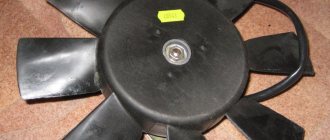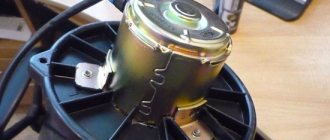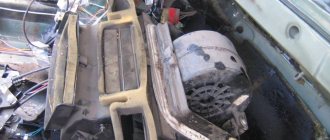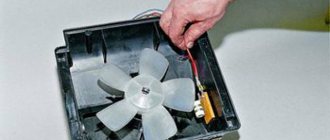The heating system of the VAZ-2114, when compared with modern cars, is designed quite simply. But it includes different elements, components and assemblies. Many people can repair the heater themselves. Especially if we are talking about replacing the resistor.
Functions of the VAZ 2114 heater resistor
The electric fan of the stove has 3 operating modes with different rotation speeds. At maximum speed, the engine is powered directly from the on-board network, and at two lower speeds - through resistor circuits with a resistance of 0.83 and 0.2 Ohms. Thanks to the resistor, the voltage on the motor winding decreases, thereby reducing its speed.
Signs of a malfunction of the VAZ 2114 heater resistor
The main sign of a breakdown of the additional fan is that the fan operates only at maximum mode. In this case, the current goes directly from the switch to the motor, bypassing the additional resistor. In addition to the breakdown (burnout) of the resistor itself, such symptoms can be caused by a faulty switch or poor contact at the resistor terminals. To check the serviceability of the part and fix the problem, you need to know where the VAZ 2114 heater resistor is located.
Location of the VAZ 2114 heater resistor
Unlike most parts of electrical equipment, the heater resistor is located in an easily accessible place - under the dashboard directly above the gas pedal. To access it, there is no need to remove or disassemble the interior trim elements. Now that we have found out where the heater resistor is located on the VAZ 2114, let’s figure out how to replace it.
conclusions
The reasons for the VAZ-2114 heater fan not working are quite simple and even a novice motorist can fix them. Of course, in 50% of cases, all malfunctions are related to the fuse, replacing which will normalize the operation. But, if the reasons are quite complex and the car enthusiast is not able to cope with them on his own, it is necessary to contact a car service center, where everything will be repaired cheaply and efficiently.
Good evening to all car enthusiasts, I read everything, everything is familiar, but the reason for me is that the fuse burns when I sharply stomp on the gas pedal, when I drive in quiet mode, the heater works and does not light up. If anyone has encountered this, please tell me what it can do be a reason?
Set the fuse to 20
Thank you very much for the detailed information! I fixed the stove in a couple of hours. The cause was a faulty contact group. Saved a good amount)))
I have a VAZ 21014 - the heater fan started to shut down, it only turned on if I drove for a while, it was like this for 3 weeks, then it stopped turning on at all. I checked the relay and resistor and fuses, but all this was in vain... then I decided to do this - I lifted the soot, removed the filter and the casing on the heater motor - I exposed the wires going to the fan with small cuts - the current rang... when I turn on the valve, but it doesn’t work... I took out this valve, turned it sideways up and pushed it to the right wing of the car there it’s wider and it came out (I cut off the wires because I had to climb out of the inside to disconnect it into the rubber band and then put it in again; I don’t want to have to suffer with getting in... I disassembled this miracle; there were pre-prepared brushes on the table - but alas, on the armature of the motor there were copper contacts in contact with the brushes completely erased in two places...a dead spot appeared.... I note that the supply of brushes was still normal. The machine is 7 years old, the fan always worked constantly - in the cold in the summer in the warm in the winter... in short, if the motor does not work, it is better to immediately buy a new one ..... I didn’t find the bearing, there is a bronze seal on the side of the brushes, and as I understand it, you can’t get to the other side without breaking it..... a new motor costs 650 rubles. You have to go buy it and push it from under the hood..... I’ll carefully connect the wires clamp and insulate it. Now I understand why these motors are not repaired, but are advised to be replaced with a new one right away.
Replacing the resistor of the VAZ 2114 stove
To carry out the work, you only need a screwdriver and a multimeter (the latter to check the functionality of the part). Before starting work, you must disconnect the negative terminal from the battery to avoid a short circuit. To dismantle the part, you must perform the following steps:
- remove the connectors from the resistor contacts;
- unscrew the VAZ 2114 resistor fastening;
- remove the additional resistor.
Before replacing the resistor with a new one, it is necessary to check the condition of the contacts and, if necessary, clean them, removing oxides. After this, you need to check the resistor circuits for open circuits using a multimeter. The resistance of the additional elements should be approximately 0.8 and 0.2 Ohms. The resistor is not intended for repair, so if the circuit of one or two additional resistances is broken, it must be replaced with a new one. Installation is done like this:
- insert the heater resistor into place;
- tighten the fastening;
- put the connectors on the contact outputs.
When the heater resistor is installed, all that remains is to connect the terminal to the battery and check the operation of the heater fan.
The device relates to the field of automotive electrical engineering, in particular to devices for regulating the rotation speed of an electric motor of a car interior heater fan. The resistor contains an electrically insulating base with contacts for connecting external circuits; a ceramic housing with an axial hole, a cavity with a bimetallic fuse and a resistive element embedded in it in the form of a nichrome spiral, with current leads, two of which partially extend into the cavity of the ceramic housing closed by a lid. A bimetallic fuse is connected to the current leads either by means of bent thinned ends of the current leads or by means of short metal pins. The technical result is to ensure protection of the electric motor power supply circuits from overcurrent and overheating of the resistive element due to a malfunction of the fan part of the heater, technologically, reliability and self-healing. 2 salary f-ly, 3 ill.
How to replace an additional heater motor resistor?
- We find an additional resistor and remove the contacts from it.
- Unscrew the fastening of the additional resistor.
- We take out the additional resistor.
- We make repairs when possible.
- Install in reverse order.
Resistor of the heating system VAZ 2110
In a VAZ 2110 car, the heating system ensures the desired temperature in the cabin. The resistor is designed to select the mode in which the fan will operate.
Motor failure
The electric motor of the heater is located in the engine compartment; it is constantly exposed to unfavorable conditions and is subject to contamination and temperature changes. All these aspects significantly reduce the service life of this unit, and in many cars of the Samara-2 family it fails after a mileage of 100-120 thousand kilometers. A new electric motor costs from 1,500 rubles assembled, so when diagnosing its malfunction, it is better to immediately replace the part with a new one. You can also try to disassemble it and change the brushes, since in most cases it is the brushes that cause the stove motor to fail.
And one more important tip
Replace the resistor immediately after identifying its malfunction.
Operating a car stove after a breakdown of the additional current converter can lead to very serious problems. If a part fails, the heater very often continues to operate at maximum speed. In the cold season, drivers may not attach any importance to the malfunction and use the stove, despite the breakdown of the converter.
Prolonged operation of the heater at high speeds can cause the heater motor to burn out or the car wiring to catch fire due to the passage of high voltage through devices that operate on current.
Unable to adjust temperature
Often, owners of domestic cars (including VAZ-2114) are faced with the impossibility of setting the air temperature on the control unit. The stove blows equally hot or cold, regardless of the position of the main lever of the automatic control system (in the photo below - located at class=”aligncenter” width=”700″ height=”452″[/img]In this case, experts note a malfunction of the dampers or malfunctions in the operation of the control unit itself. The temperature sensor is also diagnosed. It is located next to the light control lamp on the ceiling. Rotate the position of the lever several times. The air heating should change tactilely. If the temperature changes only when the sensor is in the extreme position, the element must be replaced.
What did you improve?
The modernized stove has a number of advantages:
- Quiet, and at 1st speed silent.
- Productive, at speed 1 it blows at the level of speed 2 of the old fan. At maximum speed, dust will fly out of the air ducts.
Such tuning of the heating system is mandatory for drivers of northern cities. Have you improved the Niva 4x4 stove in this way? Write reviews and additions on this modernization, take part in the survey. Let us remind you that other modifications to the SUV are published in this category.
Photo: Flea in-flight magazine
Keywords: Niva stove | Niva air ducts
Found an error? Select it and press Ctrl+Enter..
An additional resistor is used to select the operating mode of the heater fan. The additional heater fan resistor has two spirals with a resistance of 0.23 and 0.82 Ohms. When you turn the knob on the heater control panel, you can turn on either both spirals (1st speed), or a spiral with a resistance of 0.23 Ohm (2nd speed), or turn on the heater electric motor directly without a resistor (3rd speed) in the power supply circuit of the electric motor. .
1. To replace the additional heater fan resistor, unscrew the resistor mounting screw.
2. Remove the resistor from the heater housing. If the heater fan resistor coils are burnt out, replace it.
Contacts or tracks in the mounting block
The mounting block, which is located under the hood closer to the windshield, is responsible for the correct operation of all electrical devices in the car. Due to this arrangement, the block is often susceptible to corrosion due to high humidity. Over time, oxidation of contacts leads to complete loss of contacts. Cleaning all contacts from corrosion and water solves the problem for a short time. The best option is to replace the contacts with new ones. You can also use part of a plastic bottle or durable polyethylene to protect this unit from water and dirt. You can understand why the stove on a VAZ 2114 does not work in all positions after checking the main signs of a malfunction. Check fuses, relays and contacts. If the resistor is faulty, the motor will still blow in the third position. Having determined the possible causes of the malfunction, replace the faulty parts. The cost of spare parts for the system is low, so it is worth carrying spare parts with you for quick replacement.
Fuse
The best option for a malfunction is a blown fuse. A voltage drop in the vehicle's on-board network or a mismatch in the power of the fuse leads to its burnout. The location of the required element in the mounting block differs depending on the year of manufacture of the machine. In earlier copies, the heater fuse is located in the bottom row under the F7 marking. If you count from left to right, then the desired element will be the 4th in a row.
On later versions of the mounting block, the required fuse is located in the right column last, if you go from top to bottom.
In both options, the fuse capacity is 30 Amps. For quick repairs, you can store a set of new parts in the glove compartment. If the replacement does not produce results, you need to further understand why the stove does not work on the VAZ 2114.
In addition to the heater motor, fuse F7 controls the operation of other electrical devices in the car: rear window heating and windshield washer.
Why does the stove blow cold air?
In addition to the listed minor breakdowns, there are other more serious reasons why the stove stopped working. Late maintenance, poor quality materials or improper operation of the machine leads to serious problems in the cooling and heating system. Because These systems are inseparable; failure of one element affects the efficiency of heat supply to the cabin. We list the main malfunctions that affect the heat supply.
Airlock
Damage to the radiator pipes (main and cabin), damage to the pressure release cap on the expansion tank - all this causes air to enter the system. Because this system must be sealed - the presence of air in it affects the heating efficiency. Removing air from the system is a simple process, but it requires some manipulations with lifting the front of the car and adding antifreeze.
Low antifreeze level
Even with the integrity of all pipes and normal operation of the pressure release cap, the antifreeze from the tank gradually evaporates. A low liquid level does not allow the entire heater radiator to be completely covered with warm antifreeze. It is enough to add fluid to the marked level (top up with a cold engine) and then check the strength of the warm air flow.
Stove tap
The weakest structural element in the VAZ 2114 is the heater valve. In addition to periodic leakage of the faucet, it may become jammed in one position. The valve that regulates the volume of fluid entering the radiator may stick. Because of this, heat will stop flowing into the cabin in full. If attempts to adjust the cable do not bring results, replace the faucet assembly with a new one.
Dampers
A fairly obvious reason for insufficient airflow is jammed dampers. Over time, the cable tension becomes insufficient. For normal adjustment, periodically tighten the cable with pliers. You can get to it after removing the decorative trim on the driver's foot side.
Clogged heater core
Serious malfunction - clogged heater. Insufficient fluid conductivity seriously reduces the heat transfer of the radiator. The problem is aggravated by the fact that to replace the element you will have to disassemble the panel. Cleaning the housing channels does not always allow you to return the radiator to service. To avoid the problem, it is recommended not to use sealants for holes in the radiator.
Thermostat
Another important element in the design is the thermostat. Its timely operation allows you to maintain the operating temperature of the engine in any weather. If you have a working thermostat, you do not need to use various cardboards to maintain heat in the engine compartment. A stuck thermostat is a common situation. For prevention, you should periodically change the antifreeze in the system, and if necessary, replace the thermostat itself.
water pump
For constant circulation of antifreeze, a water pump is provided in the cooling system. Its work accelerates the movement of liquid. Failure leads to leakage and overheating of the motor. Symptoms of a pump malfunction include extraneous noise and uneven wear on the timing belt.
Blown cylinder head gasket
A lack of coolant leads to gradual overheating of the engine. First of all, the gasket under the cylinder head suffers. Due to overheating, the gasket is destroyed, after which antifreeze begins to enter the engine cylinders. Signs of a broken cylinder head gasket are easy to notice: the presence of an emulsion when checking the oil with a dipstick, white steam with an unpleasant odor from the exhaust pipe, overheating of the engine and the presence of gases in the expansion tank. Timely maintenance of all structural elements will keep your engine intact and also prevent a situation with a sudden failure of the stove.
Electrical equipment
A non-working heater fan, even in the warm season, can cause many unpleasant moments. For example, when it rains, the windows sweat in the absence of airflow. One of the reasons for the breakdown is a faulty resistor of the VAZ 2114 heater. In most cases, you can find and fix the problem yourself, without resorting to the services of car service specialists.
Broken wiring
Another common cause of stove failure is damaged wiring or poor contact. You can check the wiring using a conventional test lamp. To simplify the process of finding the necessary wires, below is a diagram of connecting the electric motor of the heater in Samara-2.
- Fuse box
- Egnition lock
- Heater resistor
- Heater motor
- Heater position switch
A – positive terminal of the generator
Ignition system
The second element of the car where you can find a resistor is the spark plugs. But not all candles are equipped with it.
It began to appear in the design of these elements not so long ago, and its task is to suppress radio interference.
By the way, there is now a lot of debate about whether it is needed in candles. After all, the resistor creates resistance, which ultimately affects the spark. But the stronger the latter, the better the combustible mixture ignites.
But in fact, the presence of a resistor has a slight effect on the quality of the spark, but only positively on the spark plug. A very strong spark charge leads to the destruction of the electrodes, and the resistance reduces the spark voltage.
But this is not its main purpose. A powerful spark discharge creates quite strong interference in the radio frequency range, which can affect the operation of a car audio system, mobile phone and any other equipment that is sensitive to this type of interference.
Interestingly, it is not necessary to install spark plugs equipped with resistors on the car.
The fact is that in many models a noise-reducing element is installed in the tips of high-voltage wires. Also, some types of wires themselves have quite good resistance, which is enough to suppress radio interference.
The resistor can also be installed in the distributor slider, and it is found there on many models. Its task is the same as that of a spark plug or tip.
It is important to understand that resistors cannot be used simultaneously in all of the listed ignition elements.
When these elements are connected in series, all the resistance they create is summed up.
That is, if a resistor is installed in the distributor runner, tip, or spark plug, then they will create such a strong resistance that they will significantly weaken the spark charge, and it will no longer be able to properly ignite the mixture. And this will lead to interruptions in engine operation, loss of power, and increased fuel consumption.
Therefore, deciding whether to install spark plugs with a resistor on a car is necessary by carefully reading the technical documentation that comes with the car.
If the manufacturer indicates that the use of such candles is necessary, then it is better to use them.
contact Group
If the stove on a VAZ 2114 stops working, you should look for the reason in the contacts and connections. Often the chip that goes directly to the stove fan flies off. This connection is located under the hood, so exposure to moisture can also affect the quality of the contact. Securely fasten the chip and check the functionality of the stove. The cost of connection chips is cheap, so if the contacts oxidize, it is worth replacing them. If the wiring inside the cabin is damaged, its assembled cost is also small (about 300-500 rubles per wiring).
Lighting
Recently, resistors have begun to be used in conjunction with LED lamps. This type of lamps has increasingly begun to be used on cars.
But not all cars yet come from the factory equipped with LED lighting devices, but it is quite possible to buy them separately and install them instead of standard incandescent lamps for the same turn signals or brake lights, and many do so.
But here a problem arises that requires the use of resistors.
The fact is that the electricity consumption of these lamps is very small, which is why the electronic unit regards the operation of the LEDs as a malfunction of the standard lamp.
To correct the situation, resistors are used to create a load on the wiring lines that power those lighting fixtures in which LED lamps are installed.
As a result, the ECU perceives the resistance of the element as the work of an incandescent lamp, so no error code occurs.
It is interesting that when using such decoys, the main advantage of LED lamps - low energy consumption - is reduced to zero, and they have only one advantage over conventional incandescent lamps - a long service life.











